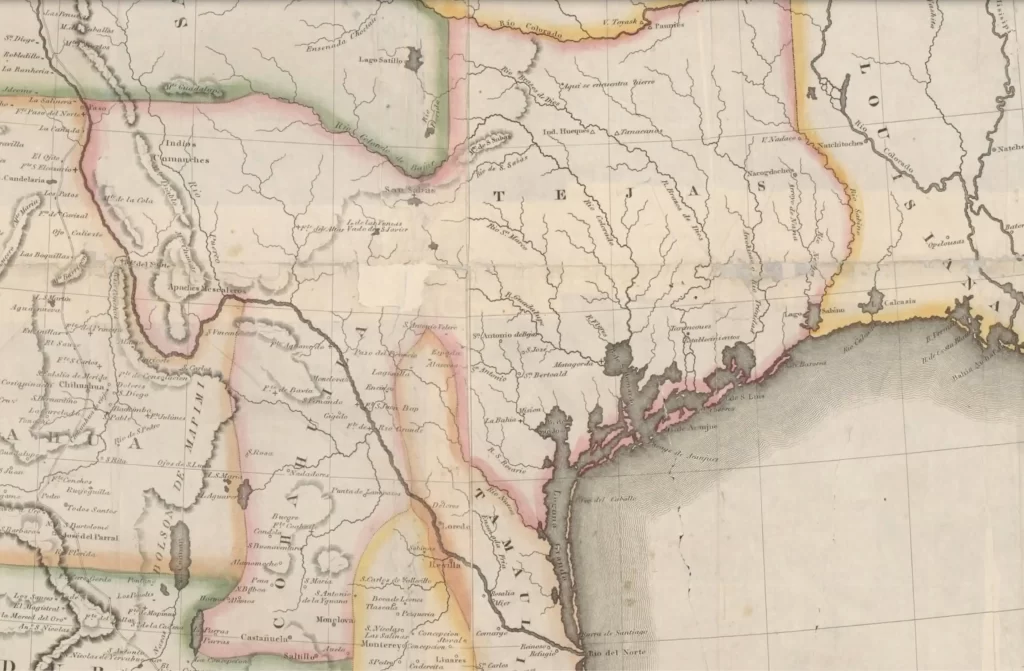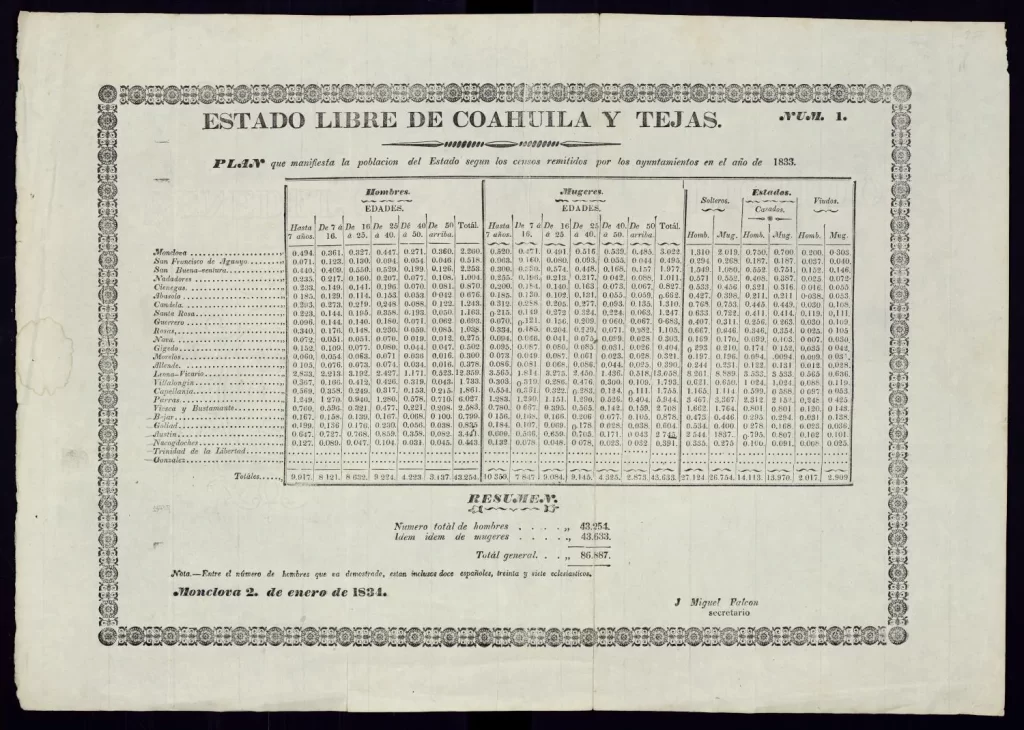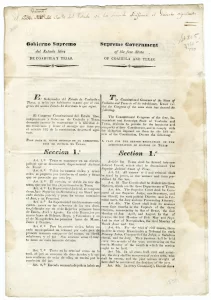The state of Coahuila y Tejas was established in 1824 as part of Mexico’s newly adopted federal system, combining the relatively stable interior province of Coahuila with the sparsely populated frontier of Texas. Although the merger appeared new in structure, it reflected deeper patterns of shared administration dating back to Spanish rule.
Beginning in the late 1600s, governors of Coahuila had intermittently exercised authority over Texas, especially during periods when Spanish missions were withdrawn or reorganized. By the 1720s, the two provinces were formally governed separately, but their administrative paths remained intertwined—often out of necessity rather than design.
The 1824 constitution rejoined them as a single state within the Mexican federation. Texas, which had few permanent settlements outside of San Antonio, was designated as a single department within the new state, with its own jefe político but limited representation in the state legislature at Saltillo. A provisional congress assembled later that year, and a full state constitution was adopted in 1827, creating a unicameral legislature and outlining the relationship between the departments.
As Anglo-American immigration increased under empresario contracts, pressure mounted to adjust the political structure. Settlers and Tejanos alike grew frustrated with distant governance, limited representation, and legal systems ill-suited to frontier conditions.
In 1833, when Monclova temporarily replaced Saltillo as the state capital, reforms were passed to address some of these concerns: Texas was divided into three departments—Béxar, Brazos, and Nacogdoches—and allowed more local municipalities, limited English-language use, and trial by jury. Still, the fundamental imbalance remained. Texan delegates, including Stephen F. Austin and Ramón Músquiz, repeatedly petitioned for separate statehood. Their efforts were rebuffed.
By 1835, the internal coherence of Coahuila y Tejas had broken down. Rival governments in Saltillo and Monclova vied for control; federal troops dissolved the legislature; and Governor Agustín Viesca was arrested en route to make San Antonio the new seat of government. These events—coupled with Santa Anna’s centralist turn—triggered a final break. In November 1835, Texans declared themselves a separate state loyal to the 1824 Constitution, setting the course for revolution.
Territory and Boundaries
The state of Coahuila y Tejas encompassed a vast and diverse stretch of northern Mexico, ranging from the rugged interior mountains of Coahuila to the coastal plains and pine forests of eastern Texas. Administratively, Texas was initially organized as the Department of Béxar, with its capital at San Antonio de Béxar, while Coahuila was divided into departments including Monclova, Parras, and Río Grande.
As population in Texas grew—especially through Anglo-American immigration—two additional departments were created in the 1830s: Brazos, centered on San Felipe de Austin, and Nacogdoches, in East Texas. These changes were intended to improve local administration and expand political representation.
Despite sharing a state government, the two regions had distinct populations, cultures, and economic structures. Coahuila, with established towns and ranching centers, was more integrated into the Mexican interior. Texas, by contrast, was characterized by dispersed settlements, a growing Anglo-American population brought in under empresario land grants, and a more distant relationship to Mexican political institutions.
The boundary between Texas and Coahuila was loosely defined in practice, but theoretically followed the course of the Nueces River, which served as the southern limit of Texas within the state. South of the Nueces lay the department of Río Grande, part of Coahuila proper. While this boundary held administrative meaning under state law, enforcement was minimal, and settlement patterns often blurred the distinction between the two regions—further contributing to confusion and eventual conflict over jurisdiction and governance.

Capitals and Governance
The official state capital shifted during the life of Coahuila y Tejas. Initially located in Saltillo, it was later moved to Monclova to appease political factions. For Texans, both locations were distant and difficult to reach. The capital was the seat of the state legislature, where laws were passed and governors selected.
Each department sent representatives to the unicameral legislature, but Texas—due to its small formal population—was given limited seats. The state was governed by an elected governor, a vice governor, and a legislature responsible for taxation, military organization, and local laws. Texas also had a political chief in San Antonio who reported to the state government.
Legal and Constitutional Framework
Coahuila y Tejas was organized under the Federal Constitution of 1824 and operated with its own state constitution, ratified in 1827. These documents gave the state substantial authority over local affairs, in keeping with the federalist ideals of early independent Mexico.
Law in the state was based on Spanish and Mexican civil codes. This included rules governing land ownership, inheritance, marriage, and slavery. Texan settlers, many of whom came from U.S. states with different legal traditions, often found these codes unfamiliar or restrictive—especially regarding property rights and the legal status of enslaved persons.

Mexico’s Settlement Strategy
After gaining independence from Spain in 1821, the Mexican government faced the challenge of securing and developing its northern frontier. In Texas, earlier Spanish efforts to populate the region through missions, presidios, and small settlements had yielded only limited success. Outside of San Antonio and a few towns along the Rio Grande, the region remained thinly populated, vulnerable to Native resistance, and exposed to foreign encroachment.
To address this, Mexican authorities adopted a new approach: issuing empresario contracts to private individuals who would bring in families—mainly from the United States—to settle designated areas of Texas. These empresarios were granted large tracts of land and were expected to organize orderly colonies under Mexican supervision.
Settlers were required to register with local authorities, obey Mexican laws, and formally convert to Catholicism, continuing a policy that had originated under Spanish rule. This requirement deterred some devout Protestants from settling in Texas, but in practice the settlers were left to worship as they pleased, and the Catholic Church had little institutional presence among the settlers. Few priests ever reached the distant colonies, and many settlers went years without seeing a Catholic service. In some areas, marriages and baptisms were performed informally or recorded only when a traveling priest passed through.
The colonization program was authorized by the 1824 General Colonization Law and implemented by the state of Coahuila y Tejas. The most successful empresario was Stephen F. Austin, who received the first contract and oversaw the settlement of the “Old Three Hundred.” Others included Martín de León, who organized a primarily Mexican colony along the lower Guadalupe River, and Anglo-American figures such as Green DeWitt, Haden Edwards, and Lorenzo de Zavala. Some colonies thrived, while others struggled due to internal disputes, financial difficulties, a failure to attract settlers, or resistance from neighboring communities and Native groups.
Although the empresario system succeeded in boosting Texas’s population and development, it also introduced long-term cultural and political tensions. Many settlers maintained loyalties to U.S. customs and governance, creating friction with Mexican authorities as Texas became increasingly distinct from the rest of the Mexican federation.
Click to Expand: Empresario Land Grant Contracts, 1823–1835
| Date of Contract | Contractor |
|---|---|
| April 24, 1823 | Stephen F. Austin, first grant |
| April 13, 1824 | Martín de León |
| April 15, 1825 | Green DeWitt |
| April 15, 1825 | Haden Edwards |
| April 15, 1825 | Robert Leftwich (later Robertson’s Colony) |
| April 15, 1825 | Frost Thorn |
| June 4, 1825 | Stephen F. Austin, second grant |
| October 22, 1825 | John G. Purnell & Benjamin D. Lovell |
| January 12, 1826 | Benjamin R. Milam |
| March 9, 1826 | Arthur G. Wavell |
| April 16, 1826 | Shawnee Indians |
| May 27, 1826 | Stephen Julian Wilson |
| November 14, 1826 | John Lucius Woodbury & Joseph Vehlein |
| December 21, 1826 | Joseph Vehlein, first grant |
| December 22, 1826 | David G. Burnet |
| May 21, 1827 | John Cameron, first grant |
| November 20, 1827 | Stephen F. Austin, “Little Colony” |
| February 23, 1828 | Richard Exeter & Stephen Julian Wilson |
| June 11, 1828 | James Power & James Hewetson |
| July 9, 1828 | Stephen F. Austin, “Coast Colony” |
| August 17, 1828 | John McMullen & James McGloin |
| September 19, 1828 | John Cameron, second grant |
| November 12, 1828 | Manuel R. Arispe |
| November 17, 1828 | Joseph Vehlein, second grant |
| February 6, 1829 | Juan Domínguez |
| March 12, 1829 | Lorenzo de Zavala |
| February 12, 1830 | Juan Antonio Padilla & Thomas J. Chambers |
| February 25, 1831 | Stephen F. Austin, “Upper Colony” |
| October 15, 1831 | Vicente Filisola |
| September 1, 1831 | Cherokee Indians |
| February 25, 1832 | Stephen F. Austin & Samuel May Williams |
| February 25, 1832 | John Charles Beales & José Manuel Royuela |
| March 14, 1832 | Mexican Company (Beales and associates) |
| May 1, 1832 | Juan Vicente Campos |
| October 9, 1832 | James Grant & John Charles Beales |
| January 1, 1834 | Fortunato Soto & Henry Egerton |
| April 19, 1834 | John T. Mason |
| April 29, 1834 | Sterling C. Robertson |
| March 14, 1835 | John Durst & Samuel May Williams |
| April 7, 1835 | James Grant |
| May 13, 1835 | Samuel May Williams, Francis W. Johnson, & Robert Peebles |
Representation of Texas
While Texas was legally part of the state, its influence in the legislature was minor. The small number of seats assigned to Texas did not reflect the growing Anglo population. This imbalance fueled growing dissatisfaction, particularly as new immigrants arrived under empresario contracts and found their interests sidelined.

Texan delegates such as Stephen F. Austin frequently petitioned for reforms—including a move of the capital closer to Texas or outright separation from Coahuila. These efforts were mostly unsuccessful, though they laid the groundwork for later calls for autonomy and independence.
Administrative Legacy
Despite its short existence, Coahuila y Tejas helped shape Texas’s early political development. Land distribution systems, court structures, and municipal government in early Texas all had roots in this period. It also exposed Texan settlers to Mexican political culture, including elections, constitutional debate, and the use of civil rather than common law.
Many future leaders of the Texas Revolution and Republic of Texas first entered public life under the government of Coahuila y Tejas.
End of the State
The state of Coahuila y Tejas was effectively abolished in late 1835, when President Santa Anna dissolved the federal system and replaced it with centralized military departments. This act violated the 1824 Constitution and alienated many in Texas who had supported Mexican federalism.
Texan resistance turned into open revolt by the end of 1835. When Texas declared independence in March 1836, it formally severed ties not only with the Mexican central government but also with Coahuila, its reluctant political partner.
📚 Curated Texas History Books
Dive deeper into this topic with these handpicked titles:
- Spanish Texas, 1519-1821
- Latin American Law: A History of Private Law and Institutions in Spanish America
- Laws and Decrees of the State of Coahuila and Texas, in Spanish and English
- Lone Star Nation: The Epic Story of the Battle for Texas Independence
Texapedia earns a commission from qualifying purchases. Earnings are used to support the ongoing work of maintaining and growing this encyclopedia.
